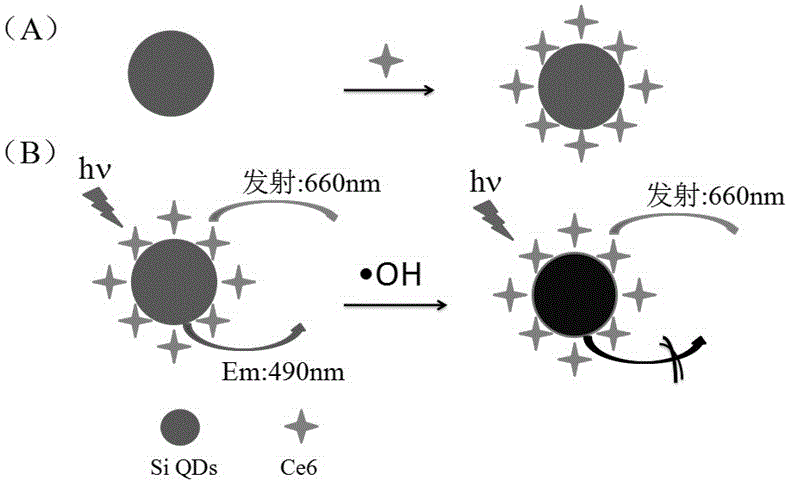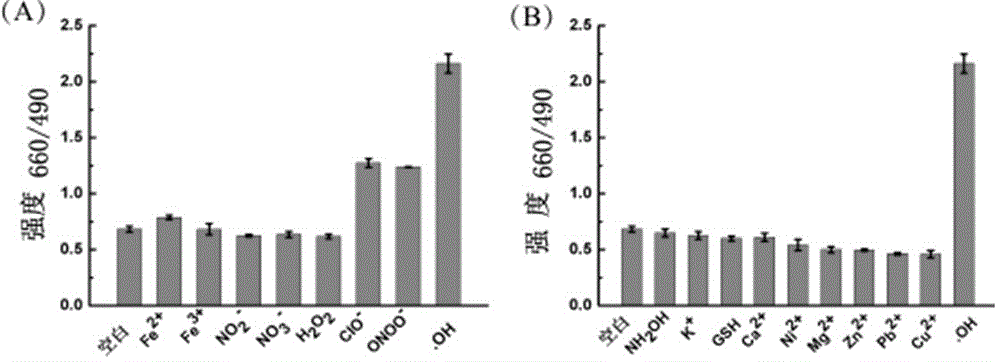Ratio-type nano silicon quantum dot fluorescence probe and preparation method and application thereof
A nano-silicon quantum dot and silicon quantum dot technology, applied in the fields of nanomaterials and molecular biology, can solve the problems of poor imaging effect and high background, and achieve the effects of stable signal, high sensitivity and high specificity
- Summary
- Abstract
- Description
- Claims
- Application Information
AI Technical Summary
Problems solved by technology
Method used
Image
Examples
Embodiment 1
[0036] (1) Preparation of silicon quantum dots
[0037] Before preparation, soak a 25mL round bottom flask with aqua regia (concentrated hydrochloric acid:concentrated nitric acid = 3:1), soak overnight, wash, dry and cool to room temperature. Adjust the rotation speed of the magnetic stirrer, add 1mL triaminopropyl-triethoxysilane (APTES), 5mL water, 1mL0.1M sodium ascorbate (NaAA) solution at room temperature, stir for 4h, the solution turns from clear and transparent to pink, Then silicon quantum dots are produced.
[0038] (2) Synthesis of silicon quantum dots-chlorin e6 composites
[0039] Mix the above-mentioned synthesized silicon quantum dots (1.9mL) and 50μMCe6 (0.1mL) at room temperature and avoid light, and let it stand for two days and two nights, and chlorin e6 is adsorbed to the surface of the silicon quantum dots by electrostatic action to obtain The silicon quantum dot-chlorine e6 composite material is denoted as Si-ce6.
[0040] After obtaining Si-ce6, use ...
Embodiment 2
[0048] (1) Preparation of silicon quantum dots
[0049] Before preparation, soak a 25mL round bottom flask with aqua regia (concentrated hydrochloric acid:concentrated nitric acid = 3:1), soak overnight, wash, dry and cool to room temperature. Adjust the speed of the magnetic stirrer, add 2mL triaminopropyl-triethoxysilane (APTES), 10mL water, 2mL 0.1M sodium ascorbate (NaAA) solution at room temperature, stir for 4.5h, the solution turns from clear to pink , the silicon quantum dots are produced.
[0050] (2) Synthesis of silicon quantum dots-chlorin e6 composites
[0051] The above-mentioned synthesized silicon quantum dots (2.5mL) and 75μMCe6 (0.1mL) were mixed at room temperature and protected from light, and left to stand for two days and two nights, and chlorin e6 was adsorbed to the surface of the silicon quantum dots by electrostatic interaction to obtain The silicon quantum dot-chlorine e6 composite material is denoted as Si-ce6.
[0052] After obtaining Si-ce6, us...
PUM
 Login to View More
Login to View More Abstract
Description
Claims
Application Information
 Login to View More
Login to View More - R&D
- Intellectual Property
- Life Sciences
- Materials
- Tech Scout
- Unparalleled Data Quality
- Higher Quality Content
- 60% Fewer Hallucinations
Browse by: Latest US Patents, China's latest patents, Technical Efficacy Thesaurus, Application Domain, Technology Topic, Popular Technical Reports.
© 2025 PatSnap. All rights reserved.Legal|Privacy policy|Modern Slavery Act Transparency Statement|Sitemap|About US| Contact US: help@patsnap.com



